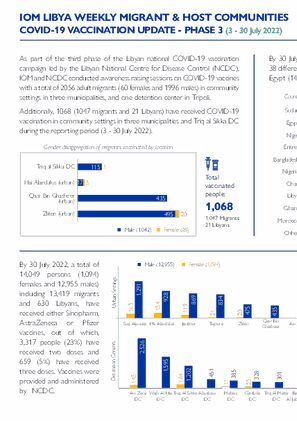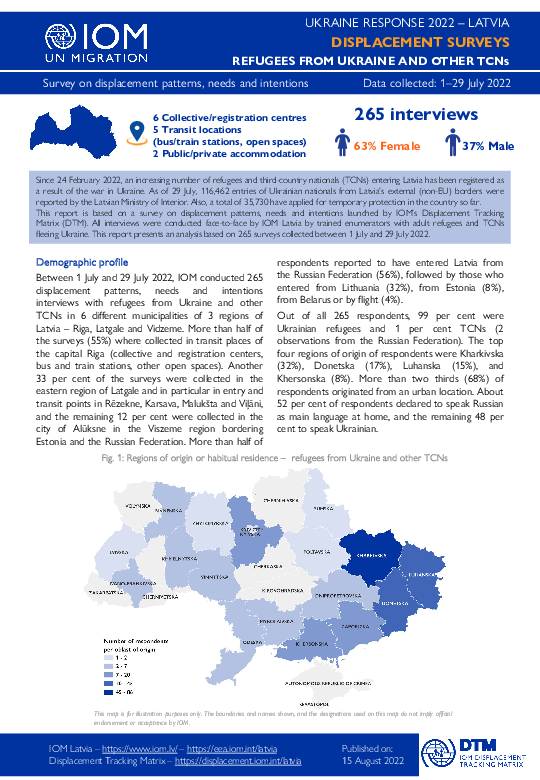-
Countries
-
Data and Analysis
-
Special Focus
-
Crisis Responses

Contact
DTM Libya, DTMLibya@iom.int
Language
English
Location
Libya
Period Covered
Jul 03 2022
Jul 31 2022
Activity
- Other
As part of the third phase of the Libyan national COVID-19 vaccination campaign led by the Libyan National Centre for Disease Control (NCDC), IOM and NCDC conducted awareness raising sessions on COVID-19 vaccines with a total of 2056 adult migrants (60 females and 1996 males) in community settings in three municipalities, and one detention center in Tripoli. Additionally, 1068 (1047 migrants and 21 Libyans) have received COVID-19 vaccination in community settings in three municipalities and Triq al Sikka DC during the reporting period (3 - 30 July 2022).
Contact
DTM Sudan, DTMSudan@iom.int
Location
Sudan
Activity
- Mobility Tracking
- Baseline Assessment
Period Covered
Dec 10 2021 -Feb 08 2022
A baseline assessment is a sub-component of mobility tracking. It aims to collect data on IDP, migrant or returnee population presence in a defined administrative area of the country.
Population Groups
Survey Methodology
Unit of Analysis Or Observation
Type of Survey or Assessment
Keywords
Geographical Scope
Administrative boundaries with available data
The current dataset covers the following administrative boundaries

Contact
DTM Libya, DTMLibya@iom.int
Language
English
Location
Libya
Period Covered
Jul 31 2022
Aug 06 2022
Activity
- Other
As part of the third phase of the Libyan national COVID-19 vaccination campaign led by the Libyan National Centre for Disease Control (NCDC), IOM and NCDC conducted awareness raising sessions on COVID-19 vaccines with a total of 3,819 adult migrants (178 females and 3,641 males) in community settings in five municipalities. Additionally, 1,704 (1,690 migrants and 14 Libyans) have received COVID-19 vaccination in community settings in three municipalities and Triq al Sikka DC during the reporting period (31 Jul - 6 Aug 2022)

Contact
DTM Libya, DTMLibya@iom.int
Language
English
Location
Libya
Period Covered
Aug 07 2022
Aug 13 2022
Activity
- Other
As part of the third phase of the Libyan national COVID-19 vaccination campaign led by the Libyan National Centre for Disease Control (NCDC), IOM and NCDC conducted awareness raising sessions on COVID-19 vaccines with a total of 634 adult migrants in community settings in Hai Alandalus, Abusleim, and janzour municipalities. Additionally, 440 (437 migrants and 3 Libyans) have received COVID-19 vaccination in community settings in three municipalities and Triq al Matar DC during the reporting period (7 - 13 Aug 2022).
Flow Monitoring is a component of DTM and it is used to track population movements inside a country, within a region or across regions. The dataset includes:
- monthly and daily figures on arrivals by sea and by land to Europe (Bulgaria, Cyprus, Greece, Italy, Malta, Spain)
- monthly and daily figures on transits along the Western Balkan region (Albania, Bosnia and Herzegovina, Croatia, Montenegro, North Macedonia, Romania, Slovenia, Serbia, Kosovo*)
- figures on reported country and areas of origin of arrivals and transits
- figures on reported migrant presence in reception centers.
Population Groups
Survey Methodology
Unit of Analysis Or Observation
Type of Survey or Assessment
Keywords
The Central American, North American, and Caribbean region has been characterised by large migratory movements. The countries of the region see the emergence of those movements, act as transit countries, and at the same time form the destinations and the points of reception of many of the migrants. It is estimated that at the end of 2021, at least 130,000 migrants reached Panama through the Darién route.
During 2021, DTM activities took place in 13 countries in the region, including flow monitoring registries and surveys in 90 bordering locations, as well as surveys of resident populations, returned migrants, and displaced persons. According to the surveys, the most common drivers of migration were the lack of job opportunities, insufficient income, the impact of COVID-19, and violence. Drought in Honduras and the recent earthquake in Haiti also contributed to internal displacement. The main needs identified were: income or employment, food, access to basic services, health and education, and legal advice. The statistics produced through DTM activities show high numbers of cross-border movements, the majority of which were monitored between the border of Haiti and the Dominican Republic. There are also large numbers of returned individuals and persons internally displaced due to natural disasters.

Contact
DTM Europe, DTMMediterranean@iom.int
Language
English
Location
Latvia
Period Covered
Jul 01 2022
Jul 29 2022
Activity
- Survey
- Flow Monitoring
Since 24 February 2022, an increasing number of refugees and third-country nationals (TCNs) entering Latvia has been registered as a result of the war in Ukraine. As of 29 July, 116,462 entries of Ukrainian nationals from Latvia’s external (non-EU) borders were reported by the Latvian Ministry of Interior. Also, a total of 35,730 have applied for temporary protection in the country so far.
This report is based on a survey on displacement patterns, needs and intentions launched by IOM’s Displacement Tracking Matrix (DTM). All interviews were conducted face-to-face by IOM Latvia by trained enumerators with adult refugees and TCNs fleeing Ukraine. This report presents an analysis based on 265 surveys collected between 1 July and 29 July 2022.
Czechia
IDPs tracked
Displacement Movements
No figure is available
IDMC 2023
Data collection round

Contact
DTM Yemen, iomyemendtm@iom.int
Language
English
Location
Yemen
Period Covered
Aug 07 2022
Aug 13 2022
Activity
- Mobility Tracking
IOM Yemen DTM’s Rapid Displacement Tracking (RDT) tool collects data on estimated numbers of households forced to flee on a daily basis from their locations of origin or displacement, allowing for regular reporting of new displacements in terms of estimated numbers, geography, and needs. It also tracks returnees who returned to their location of origin.
From 1 January to 13 August 2022, IOM Yemen DTM tracked 8,151 households (HH) (48,906 Individuals) who experienced displacement at least once.
Between 7 and 13 August 2022, IOM Yemen DTM tracked 423 households (2,538 individuals) displaced at least once. The majority of people moved into/within the following governorates and districts:
- Shabwah (313 HHs) – Ataq (141 HHs), Markhah As Sufla (49 HHs), Ar Rawdah (46 HHs) districts. All displacements in the governorate were internal.
- Marib (88 HHs) – Marib City (63 HHs), Marib (18 HHs), Harib (7 HHs) districts. Most displacements in the governorate originated from Marib and Shabwah.
- Taiz (11 HHs) – Al Mudhaffar (4 HHs), Al Qahirah (4 HHs), Al Makha (2 HHs) districts. Most displacements in the governorate originated from Al Hodeidah and Taiz.
The majority of people moved from the following governorates and districts:
- Shabwah (325 HHs) – Ataq (313 HHs), Bayhan (8 HHs), Osaylan (4 HHs) districts.
- Marib (56 HHs) – Marib City (40 HHs), Raghwan (8 HHs), Harib (7 HHs) districts.
- Al Hodeidah (19 HHs) – Al Marawiah (6 HHs), Hays (5 HHs), Az Zuhrah (3 HHs) districts.


